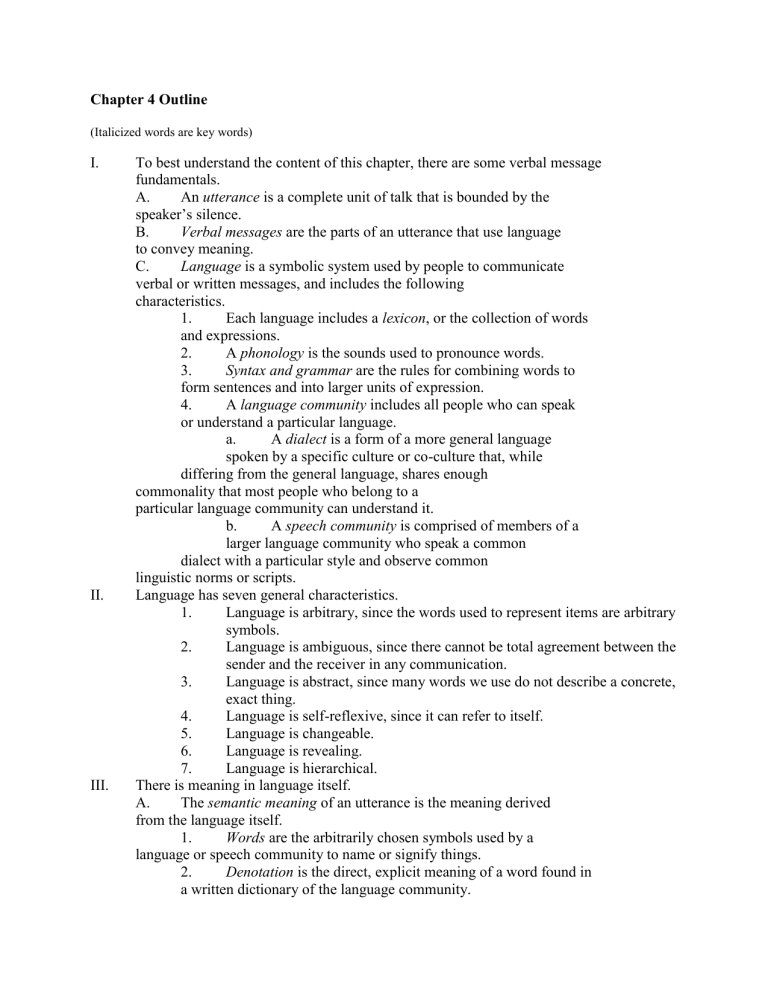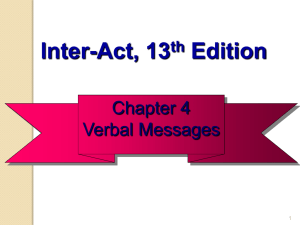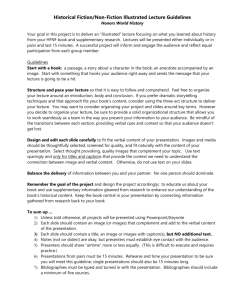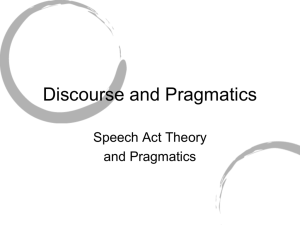Chapter 4 Outline I. To best understand the content of this chapter

Chapter 4 Outline
(Italicized words are key words)
I. To best understand the content of this chapter, there are some verbal message fundamentals.
A. An utterance is a complete unit of talk that is bounded by the speaker’s silence.
B. Verbal messages to convey meaning.
are the parts of an utterance that use language
C. Language is a symbolic system used by people to communicate verbal or written messages, and includes the following characteristics.
1. Each language includes a and expressions. lexicon , or the collection of words
2. A phonology is the sounds used to pronounce words.
3. Syntax and grammar are the rules for combining words to form sentences and into larger units of expression.
4. A language community includes all people who can speak or understand a particular language. a. A dialect is a form of a more general language spoken by a specific culture or co-culture that, while differing from the general language, shares enough commonality that most people who belong to a particular language community can understand it. b. A speech community is comprised of members of a larger language community who speak a common dialect with a particular style and observe common linguistic norms or scripts.
II. Language has seven general characteristics.
1. Language is arbitrary, since the words used to represent items are arbitrary
2. symbols.
Language is ambiguous, since there cannot be total agreement between the sender and the receiver in any communication.
3.
4.
5.
Language is abstract, since many words we use do not describe a concrete, exact thing.
Language is self-reflexive, since it can refer to itself.
Language is changeable.
6. Language is revealing.
7. Language is hierarchical.
III. There is meaning in language itself.
A. The semantic meaning of an utterance is the meaning derived from the language itself.
1.
2.
Words are the arbitrarily chosen symbols used by a language or speech community to name or signify things.
Denotation is the direct, explicit meaning of a word found in a written dictionary of the language community.
IV. Language skills may be improved using the following strategies.
A. By using specific language, ambiguity and abstractness may be reduced.
1. Specific language is language in which concrete and precise words, details, and examples are used to clear up any ambiguity.
2.
3.
Concrete words appeal to our senses.
Precise words narrow a larger category to a smaller group within that category.
B. It is important to provide dating information to the intended audience.
1. Dating information is the information about time or time period used in communications to improve clarity.
Messages can be made clearer by using the skill of dating to indicate when 2. the information that is being conveyed is accurate.
C. To improve the clarity of one’s communication, one should index any generalizations one makes.
1. Indexing generalizations is the mental and verbal practice of acknowledging individual differences when voicing generalizations.
2. The misuse of generalizations contributes to perpetual inaccuracies.
D. To be a better communicator, one should adapt language to listeners.
1.
2.
Use vocabulary the listener understands.
Use jargon, technical terminology whose meaning is understood only by a select group based on their shared activities or interests, sparingly.
3. Use slang, informal vocabulary developed and used by particular groups in society, only when the listeners understand.
E. The final way to use language more clearly is to demonstrate linguistic sensitivity.
1. Linguistic sensitivity is choosing to use language that respects others and avoiding language that others perceive as offensive.
2. Generic language is language that may apply only to one sex, race, or other group that is used in a way that assumes it represents everyone.
V. There are verbal meanings within the conversational context.
A. The pragmatic meaning of the language in a verbal message is the meaning that arises from understanding the practical consequences of an utterance.
B. A speech act is the action the speaker takes by uttering a verbal message that implies how the listener should respond.
C. There are some guidelines for improving pragmatic understanding based on the cooperative principle, which states that conversational partners are able to understand what others mean to do with their verbal messages because they assume that their partners are collaborating.
D. Grice’s conversational maxims are specific rules that cooperating partners count on others to follow. You can use these four maxims and two tips to help develop pragmatic competence.
1. Tell the truth, the whole truth, and only the truth, also known as the
“quality maxim.”
2.
Provide the “right” amount of information, formally known as the
“quantity maxim.”
3. Relate what you say to the topic being discussed, which is the
“relevancy maxim.”
4.
Be orderly in what you say; this is the “ manner maxim.”
5.
Acknowledge when you are violating a maxim.
6. Rely on the cooperative principle when interpreting violations of the maxims.
VI. Different meanings exist within social and cultural contexts.
A. The sociolinguistic meaning of a message is the meaning of a verbal message that varies according to the language norms and expectations of a particular cultural or co-cultural group.
1. All cultures develop idioms which are expressions used by members of a language or speech community whose meaning differs from the usual meanings associated with that combination of words.
2. An indirect verbal style is characterized by message language that masks the speaker’s true intentions and by roundabout, vague message content whose real meaning is embedded in the social or cultural context.
B. There are three guidelines for improving sociolinguistic understanding.
1. Develop intercultural competence.
2. Practice mindfulness, the process of drawing novel distinctions.
3. Recognize, respect, and adapt to the sociolinguistics practices of others.










![[W6 T8] Pragmatics – The Pragmatists](http://s3.studylib.net/store/data/009707198_1-00d356a5e14d3df7f71860c97446e828-300x300.png)